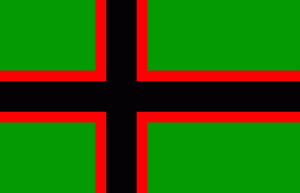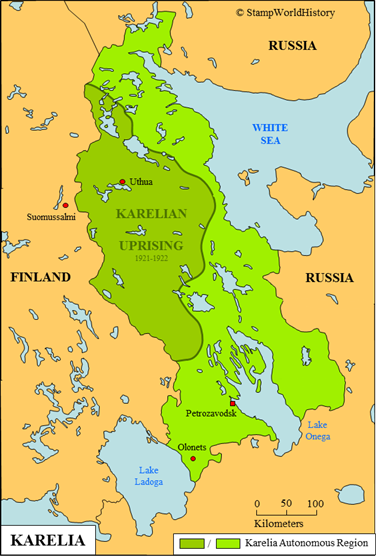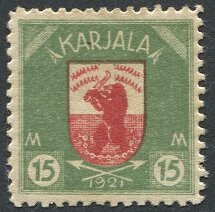
Karelia
Quick reference
General issues: Karelian uprising
Country name on general issues: Karjala
Related issues: Finnish occupation Aunus 1919, Finnish occupation East Karelia 1941-1943
Currency: 1 Markka = 100 Penni
Population: No statistics available for the area of the Karelian Uprising – All of Karelia had a population of 144 000 in 1920
Political history Karelia
Prelude
Historically, Karelia is the region, in northern Europe, inhabited by the Karelians – a Finnic people. In the early 19th century, Karelia was divided between the grand duchy of Finland – ruled by the tsar of Russia in personal union – and the Russian empire proper. In 1917, the October Revolution brought the Bolsheviks to power in Russia. Civil war ensued and several ethnic minorities proclaimed independence. In December 1917, Finland proclaimed independence – recognized by Russia in 1918. In Russian Karelia, the October Revolution triggered a complex series of events. Provisional governments were formed in opposition to the Bolsheviks.[1]In 1919, the Provisional Government of Karelia was formed in Uthua, and, in 1920, the Olonets Government of Southern Karelia was formed in Olonets. From Finland, military expeditions invaded Karelia with the aim of annexing Karelia.[2]In Finland, the concept of a ‘Greater Finland’ had gained significant support. A Greater Finland, that – aside from the Fins – would also include other Finnic peoples. From that perspective, Finnish volunteers organized military expeditions with the aim of annexing Russian Karelia – the Viena expedition in 1918 and the Aunus – Finnish for Olonets – expedition in 1919. Furthermore, regular Finnish forces occupied two areas in which the population had voted for association with Finland. However, by 1920, the Bolsheviks had gained control of most of Karelia. The ‘Karelian Question’ was settled between Finland and Russia by way of the 1920 Treaty of Tartu, in which Finland reneged claims to Russian Karelia. Russia established Karelia as an autonomous region within the Russian S.F.S.R.[3]The Russian Soviet Federative Socialist Republic was established after the 1917 October Revolution. In 1922, it was the largest founding member of the Soviet Union. , administered by a Workers Committee.
The Karelian Uprising
Although the Bolsheviks had gained control of Karelia, opposition smoldered. When discontent with Bolshevik rule grew, the opposition organized itself into paramilitary units called ‘Forest Guerrillas’. In 1921, the Forest Guerrillas effectively gained control of a growing part of Karelia. In Finland, Karelians in exile formed the Karelian United Government. In October 1921 at a meeting of the Forest Guerrillas in Uthua[4]Currently Kalevala , independence of Karelia was proclaimed – the start of the Karelian Uprising. Supported by the Karelian United Government, the Forest Guerrillas openly engaged in military conflict with the Bolsheviks in October 1921. The Karelian separatists were supported by volunteer units from Finland that actively took part in the conflict. By December 1921, the territory controlled by separatists reached its largest extent. However, the Bolshevik counteroffensive was soon to follow, and the separatists were defeated by February 1922.
Aftermath
Karelia formally became an autonomous socialist Soviet republic within the Russian S.F.S.R. in 1923 – the Russian S.F.S.R. having become a part of the Soviet Union in 1922. During WWII, when Germany invaded the Soviet Union in 1941, Finland followed suit and occupied part of Karelia. The occupied territory was administered by Finland as East Karelia through military administration until 1944, when the Soviets launched their counteroffensive and regained Karelia. Having gone through a number of administrative changes since 1923, Karelia is, currently, a republic in the Russian Federation. The Karelians are, in modern day Karelia, a 7% minority.
Postal history Karelia
Karelia issued stamps during the Karelian Uprising in 1922. The stamps were issued on 31 January 1922 and valid for use until 6 February 1922.[5]Source: the Michel catalog. The Scott catalog notes that the stamps were valid until 16 February 1922. In Karelia, the stamps were only used in Uthua. Later use is known from the Finnish town of Suomussalmi – essentially as labels in addition to franking with regular Finnish stamps. The stamps were designed in Finland, in 1921, and are inscribed ‘1921’. The Karelia issues are extensively forged. For an excellent discussion of these forgeries, please refer to the ‘Karelia and the Bear Forgeries of 1922’ page on the Big Blue 1840-1940 blog.
Stamps for specific use in Karelia were also issued by Finland during the 1919 Aunus – Finnish for Olonets – expedition, and between 1941 and 1943 during the Finnish occupation of East Karelia. These issues are discussed in the profile of Finland.
Album pages
← Previous page: IcelandNext page: Latvia →



